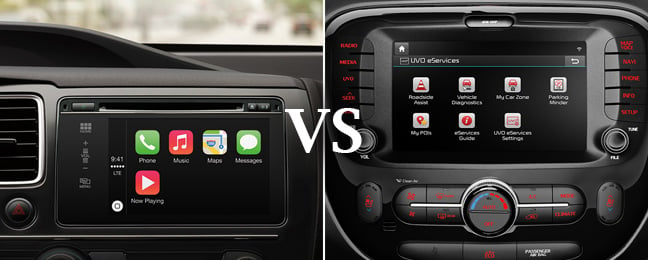

Apr 21 2016
Vehicle technology is not only becoming more widespread and more affordable each model year, but increasingly more complex. And with that, it can be difficult for vehicle shoppers --and even vehicle marketers-- to distinguish between the common technologies on offer. This could be attributed to the marketing names given by the OEMs or their nuances in functionality.
Vehicle infotainment systems and vehicle telematics systems, in particular, are two technology features that often get confused as they both overlap in several areas, including use of the same display and user interface. Some OEMs have even combined these two systems as one (Exs.Kia Uvo, AcuraLink, Lexus Enform, and BMW ConnectedDrive), sometimes referred to as multimedia systems.
In this article, we've clarified some of the differences between these two systems to help consumers make well-informed decisions when purchasing their next vehicle.
Vehicle infotainment systems combine hardware and software to offer entertainment and information features including:
Infotainment systems offer some of drivers' top desired features in a central interface, delivering greater utility than a smartphone plugged into the auxiliary jack. Drivers can talk hands-free with Bluetooth connectivity, receive GPS route guidance, watch movies or listen to music while driving - all at the same time. They are typically controlled by buttons, voice command, touchscreen, or a combination of these methods. These systems vary in ease of use, with some being non-intuitive and distracting while driving --even after the initial learning curve-- and other systems more user-friendly and safe to operate while en route.
Consumers will often find infotainment systems pre-installed in cars and light-duty trucks from major automakers including BMW, Ford, Chrysler, Honda, Mazda, Subaru, Toyota, Tesla, and others. While each automaker has their own branded infotainment system, Apple and Android also have infotainment systems that work similarly to the iPhone and Android devices, using the same operating systems. Consumers who are already used to their smartphone, and do not want to learn another technology, may enjoy using these infotainment systems instead of the OEM branded vehicle infotainment system.
These infotainment systems can be tethered to aftermarket stereos, so vehicles that lack built-in infotainment systems can be upgrade accordingly. Consumers can expect the Apple CarPlay and Android Auto platforms to be made available for all cars at some future date. View this article to learn more about infotainment systems on the market.
As the "telematics" name suggests, a vehicle telematics system combines telecommunication and informatics. The primary differences between this system and the infotainment system are that a vehicle telematics system has two-way communication that sends, receives and stores information, but generally does not include entertainment features. Utilities commonly found in a vehicle telematics system include:
Typically, an onboard device provides informatics and telecommunications assistance, including vehicle diagnostics information, driver behavior, and location assist. Many of these functions run automatically without input from the driver. There are also many aftermarket telematics devices that connect to the OBD-II port, such as Intellimec .
Telematics systems do offer useful information for drivers, including "connected car" features like weather and live traffic. Some even integrate with social media. That said, their focus is on monitoring the vehicle, driver's performance and safety, and not on entertaining drivers and passengers.
Information gathered by the telematics system may be used to communicate driver information to your auto insurer or to police after an accident or to help your mechanic diagnose auto problems. Fans of vehicle telematics systems expect that they will personalize the driving experience. For example, careful drivers can be rewarded with lower insurance premiums, known as Usage Based Insurance (UBI), courtesy of data gathered by the telematics system. This can benefit high-risk driver groups, such as teens or seniors, by no longer penalizing all group members for the poor driving habits of some.
This is another key distinction between telematics and infotainment; the former helps you drive safely and communicates externally, the latter is an entertainment and information system that only benefits drivers and passengers.
Vehicle infotainment systems can be seen as a luxury feature or add-on that's been designed to appeal to consumers who want the latest gadgets in their car. Telematics systems, on the other hand, help automakers, insurers, and drivers and are more likely to be seen as a baseline safety feature in future generations of autos. Drivers of all vehicles can expect to see telematics pre-installed in their cars going forward.
With understanding of what these systems do, and how they differ, vehicle shoppers can understand what they are buying when their next car comes with one or both of these systems. And vehicle marketers can properly capture these features in their messaging.
Photo Credits: smoothgroover22, Wikipedia